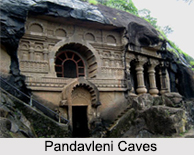 Pandavleni Caves are a group of 24 caves carved between the 1st century BC and the 2nd century AD, representing the Hinayana Buddhist caves. The location of the caves is a holy Buddhist site and is situated about 8 km south of Nashik in the state of Maharashtra. Most of the caves are Viharas except for the 18th cave which is a Chaitya. The caves have idols of Lord Buddha and Bodhisattva and the icons of Jain Tirthankara Rishabhadeva, Veer Manibhadraji and Ambika Devi.
Pandavleni Caves are a group of 24 caves carved between the 1st century BC and the 2nd century AD, representing the Hinayana Buddhist caves. The location of the caves is a holy Buddhist site and is situated about 8 km south of Nashik in the state of Maharashtra. Most of the caves are Viharas except for the 18th cave which is a Chaitya. The caves have idols of Lord Buddha and Bodhisattva and the icons of Jain Tirthankara Rishabhadeva, Veer Manibhadraji and Ambika Devi.
History of Pandavleni Caves
Pandavleni Caves can be traced back up to 3rd century BC. The various inscriptions confirm that Nashik in that period was ruled by 3 kings – The Kshatrapas, The Satavahanas and The Abhiras. The inscriptions of Cave No.10 reveal that in 105-106 BC, Kshatrapas defeated the Satavahanas after which Kshatrap Nahapana"s son-in-law and Dinika"s son- Usabhdatta donated 3000 gold coins for this cave as well as for the food and clothing of the monks. Usabhdatta"s wife, Dakshmitra also donated one cave for the Buddhist monks.
Etymology of Pandavleni Caves
Pandavleni Caves were called "Pundru" which in Pali language means "yellow ochre colour". This is because the caves were the residence of Buddhist monks who wore "the chivara" or the "yellow robes". Later on, the word Pundru changed to "Pandu Caves". Decade"s later people started calling it "Pandav Caves" or "Pandavleni Caves". The Pandavleni Caves are also known as “Trirashmi Caves†by the local people.
Caves of Pandavleni Caves
Pandavleni Caves were carved out in the 1st and 2nd century. They were built as abodes for the idols of the Jain kings. The caves have idols of Buddha and Bodhisattva and the icons of Jain Tirthankara Rishabhadeva, Veer Manibhadraji and Ambikadevi. Some caves are intricately connected by stone-cut ladders that join them to the other caves. Steps lead to the caves from the bottom of the hill.
 Attractions in the Pandavleni Caves
Attractions in the Pandavleni Caves
Some of the caves are large and contain numerous chambers. These rock-cut caves served as a Viharas or monasteries for the disciples to meet and hear sermons. These caves also contain interesting sculptures. One of the vihara caves is older and finer in sculptural detail and is thought to be nearly as old as the Karla Cave near Lonavala. Cave No.18 is a Chaitya and has an elaborate facade. The site has an excellent ancient water management system and skilfully chiselled out of solid rock are several attractive water tanks.
The caves can be traced back to 1st century B.C. Out of the 24 caves, 2 caves are a major attraction - the main cave which is the Chaitya (prayer hall) has a beautiful Stupa; the second one is Cave No. 10 which is complete in all structures as well as inscriptions. Both the caves have carvings and inscriptions also. The caves are facing eastwards. The Inscriptions in caves 3,11,12,13,14,15,19 and 20 are legible. Idols of Buddha and Bodhisattva are identified as those of Yudhisthir, Bhima, Arjun, Nakul, Sahadev, Lord Krishna and Karna.
Since the caves were inhibited by the Mahayana as well as the Hinayana sects of Buddhism, one can see a nice confluence of structural architecture and carvings.
Visiting Information of Pandavleni Caves
Pandavleni Caves are located high in the mountains of Trirashmi. Steps lead to the caves from the bottom of the hill. The peak of the Trirashmi Caves is also accessible by trekking of about 20 mins but the path is treacherous and dangerous. Nashik is well connected by train to the many major cities in the Maharashtra from the Nashik Railway Station. The nearest airport to the Pandavleni Caves is the Gandhinagar Airport which is located in Nashik.




